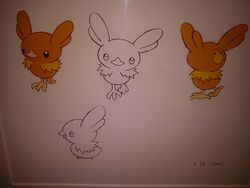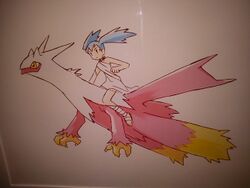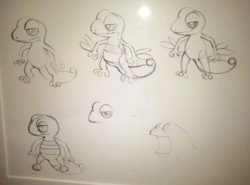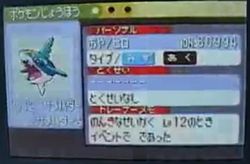Pokémon Ruby and Sapphire beta
Several things were originally going to be added to Pokémon Ruby and Sapphire during their development. Some were dropped or changed, and some of the dropped concepts of the prototypes can still be found in the games' programming.
Gameplay
Battles
It seems that wild double battles were planned to occur in these games in addition to the double battles against Trainers. This is evidenced by a piece of text found in the games' code: "Wild \v[&H05] and \v[&H03] appeared!", with \v[&H05] and \v[&H03] being placeholder values used by the game to display the names of the Pokémon that the player would encounter.
Prototype music
Generation II music
Some remastered Generation II music exists, inaccessible in the coding of Ruby and Sapphire. Known pieces include:
- Background music used on Routes 38 and 39.
- Background music used in the Pokémon Communication Center.
- Background music used in Saffron City during Generation II.
- Background music used in battles with the legendary beasts in Pokémon Crystal.
- Team Rocket's theme.
All of these themes came from Pokémon Gold, Silver, and Crystal. These may either be early pieces of music used as stand-ins, or may have hinted at Game Freak having an intent to develop remakes of Gold and Silver (which were later done in Generation IV) instead of or in addition to one of Red and Green, or even including Johto and/or Kanto, à la Gold, Silver, and Crystal. It is possible that this music was only for tests, as they appear in the game programming before the actual music played during the game.
Other music
The Contest theme, which plays during the appeals round, appears both as its whole variation in addition to four sub-tracks which combine to play the full tune. The sub-tracks are next to the normal music in the games' coding, indicating that they were initially intended to be used, though with what purpose is unknown.
Another song in the programming is a variation of the Littleroot Town theme, which lacks the introduction and instead goes straight to the loop point.
Abilities
An ability known as Cacophony was found within the games' programming; however, no Pokémon have it (unless they are hacked to have it). It is identical to Soundproof, another sound-based ability, and it allows the Pokémon to avoid all sound-based moves. Since it is identical to Soundproof (thus including it in the final version would have been redundant), some Pokémon with Soundproof may have originally been intended to have Cacophony instead, such as Whismur's evolutions Loudred and Exploud, well-known for their loudness.
A Pokémon that has been hacked to have Cacophony will regain the normal ability it should have (according to its personality value) if it is migrated to Generation IV. However, it has not been fully confirmed that the ability is not present within the coding of the Generation IV games.
Pokémon
In an interview in Nintendo Power, it was revealed that Shellos and Gastrodon were originally designed for Generation III instead of Generation IV. These are not the forms in the final versions, however; Diamond and Pearl's programming code reveals a back sprite for both Pokémon, but no front sprite. Shellos's sprite is pink, like its West Sea variation, and seems to combine the western variation's head with the eastern variation's body, while Gastrodon's sprite is brown and looks like its western variation, but with more rock-like protrusions on its body.
There were also numerous changes to Pokémon included in the games. The early version of Torchic is nearly identical to the current designs, aside from the large floppy ears. Another image depicts a creature with traits of both Latias and Blaziken, along with an unused Trainer. Concept art of Treecko also shows numerous designs for the Pokémon before the final design was decided.
| Beta design of Torchic | Beta design of Latias/Blaziken and unused Trainer | Concept art of Treecko |
Graphics
Some unused graphical elements have been found within the games' coding. Official screenshots also reveal a different representation of certain parts of the graphics. Examples of this include:
- Team Aqua sprite - An alternate, unused sprite of a member of Team Aqua is found in the game; this sprite is identical to that of male Aqua Grunts with the exception of a mirrored body, modified coloration, the addition of a mustache, and a bandanna around the Grunt's left arm.
- Pokédex sprite - What appears to be a prototype model of the sprite that is used for a Pokémon the player has not seen is two blocky, big and white question marks instead for the round and black one with a white circle and a white question mark.
- Tilesets - There is data for an unused tileset, which could have been intended for the Mossdeep City Gym or the Trick House.
- Poké Mart - In some early screenshots, Poké Mart roofs are colored red instead of blue.
- HP bar - There is an HP bar that was different from the final version.
- Beta Pokémon sprites - There are beta sprites of several Pokémon drawn in a style different from the released game, including Shroomish, Duskull, Wailmer, Wynaut, and Sharpedo.
| Unused Team Aqua sprite | Unused default Pokédex entry sprite | Used default Pokédex entry sprite | Red roof Poké Mart and black-suited Gentleman |
Demo
| Sharpedo's lack of ability. In the place where the ability description should be, it says "It doesn't have an ability." |
A demo was available at the Pokémon Festa 2002 in Japan. There were beta versions of Route 104 and the Pretty Petal Flower Shop, which is 'not yet open' according to the lady inside. There is also an unfinished version of the party screen, alongside a battle system more thoroughly developed in comparison to what was seen in older screenshots. When the battle starts, it is not possible to see how many Pokémon the Trainers have. Some moves, like Surf and Faint Attack, are depicted with different animations than those seen in the final version. It is also shown that Sharpedo has no ability in the demo; it could mean that not all Pokémon could have abilities. Given Sharpedo's low level in the demo, it could also mean that Carvanha didn't exist at the time.
Remnants of the demo
The alternative versions of Route 104 and the Pretty Petal Flower Shop still exist within the coding of the final release; though the associated tileset data for the beta Route 104 has since been removed.
The music used in the demo for Trainer battles was used for wild Pokémon battles in the final version.
Unused dialogue data, associated with the Pokémon Festa 2002 demo exists within the final game. The text remains untouched in the Japanese versions but has been translated in localized versions of the game.
| |
| This video is not available on Bulbapedia; instead, you can watch the video on YouTube here. | |
Older text
Pokémon AGB
Certain text refers to Pokémon AGB (short for Pokémon Advanced Game Boy), the once tentative title for Pokémon Ruby and Sapphire. They are presumably from the early alpha stages of development.
- "Message 1: This is sample message 1. Welcome to the world of POKéMON AGB! We hope you enjoy this!"
- "Message 2: This is sample message 2. Welcome to the world of POKéMON AGB! We hope you enjoy this!"
- "Message 3: This is sample message 3. Welcome to the world of POKéMON AGB! We hope you enjoy this!"
Day-Care Mail
Additional unused text makes reference to a Pokémon raised in the Day-Care receiving a piece of Mail, presumably if raised with a Pokémon from another Trainer. It is not known why this mentioned feature did not make it into the final game. This piece of text reads:
"By the way, about your (PKMN) it seemed to be friendly with (TRAINER?)'s (PKMN2). I may even have seen it receiving a piece of MAIL."
Leftover text remains from a prototype version of Pokémon Ruby[1]. Some of the text is not present within the final game, though there are still references to some of the options such as "Init comm. data", "Set highest score", "Reset highest score" and "Set all art museum items".
Prototype Ruby
A German-language prototype version of Pokémon Ruby was apparently sold by a Nintendo representative to an anonymous user "drx". The prototype has many debugging features, which can be accessed by scrolling through a section presumably relevant to who developed that aspect of the game. For example, choosing "WATANABE" attempts to save the game (though unsuccessfully) and selecting "KAGAYA" allows the player to view his or her Trainer Card, the opponent's Trainer Card or activate the slot machine interface.
| |
| This video is not available on Bulbapedia; instead, you can watch the video on YouTube here. | |
Limitations
Junichi Masuda stated that while developing Ruby and Sapphire, Game Freak considered changing the number of Pokémon the player can have and the number of moves a Pokémon can learn; however, the idea was later scrapped. It is currently unknown what sort of potential changes were to be made, and as of Generation V, no changes like this have been made to the series.
References

|
This game-related article is part of Project Games, a Bulbapedia project that aims to write comprehensive articles on the Pokémon games. |





